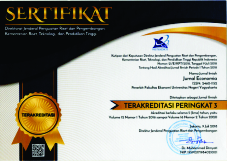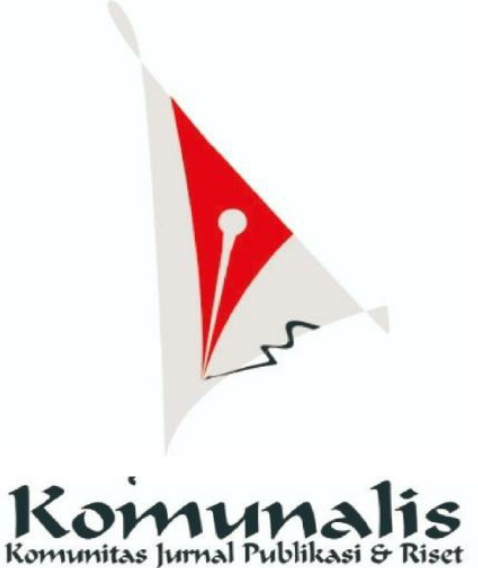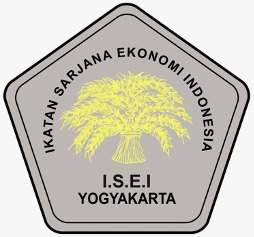Analysis of Funding, Education Performance, and Economic Growth in Indonesia
Downloads
Abstract: Higher education budget allocations affect educational performance, and it also can improve human capital to boost the economic growth of a nation. Concerning this, the present study was implemented to find out the extent of educational performance effect towards the economic growth, and what variables are the most influential determinants to boost economic growth in Indonesia related to educational sector. Fixed effect approach through data panel was used to analyze the secondary data obtained from 34 provinces in Indonesia from 2014 to 2016. The result showed that educational performance in each province in Indonesia measured by using the pure participation rate of junior high school students and high school graduates and higher education graduates were able to increase the economic growth with the assumption that their skills were sufficient to increase productivity, whereas, crude participation rate of junior high school, senior high school graduates, and higher education graduates can be an obstacle to economic development. Also, the determinant factor to boost economic growth was public spending on education sector.
Keywords: funding, education performance, economic growth
Analisis Pembiayaan, Kinerja Pendidikan, dan Pertumbuhan Ekonomi di Indonesia
Abstrak: Alokasi anggaran pendidikan yang makin besar memberikan efek terhadap kinerja pendidikan sekaligus memperbaiki mutu manusia yang dapat mendorong laju pertumbuhan ekonomi. Dalam kaitannya dengan hal tersebut studi ini dilakukan dengan tujuan untuk melihat seberapa besar pengaruh kinerja pendidikan terhadap pertumbuhan ekonomi dan variabel apa saja yang memiliki determinasi paling kuat mendorong pertumbuhan ekonomi di Indonesia yang terkait dengan sektor pendidikan. Metode analisis yang digunakan adalah panel data melalui pendekatan fixed effect, dengan menggunakan data sekunder untuk 34 provinsi di Indonesia selama periode 2014 – 2016. Hasil analisis menunjukkan bahwa kinerja pendidikan setiap provinsi di Indonesia yang diukur dari APM SLTP dan tamatan SLTA dapat meningkatkan pertumbuhan ekonomi dengan asumsi bahwa keterampilan mereka cukup memadai untuk meningkatkan produktivitas, sementara APK SLTP, lulusan SLTP dan lulusan perguruan tinggi dapat mengganggu pertumbuhan ekonomi. Sedangkan faktor determinan mendorong pertumbuhan ekonomi adalah variabel belanja publik sektor pendidikan.
Kata Kunci: pembiayaan, kinerja pendidikan, pertumbuhan ekonomi
Downloads
Ahmad, M. & Muhammad, L., (2012). Secondary Education and Economic Growth in Developing Countries: A Case Study of Pakistan. Interdisciplinary Journal of Contemporary Research in Business, 4 (3), 306 – 313.
Akcali, B. Y. & Sismanoglu, E. (2015). Innovation and The Effect of Research and Development (R&D) Expenditure on Growth in Some Developing and Developed Countries. Procedia - Social and Behavioral Sciences, 195, July, 768 – 775. Diakses dari https://www.sciencedirect.com/science pada tanggal 19 Juli 2019.
Arham, M. A., (2014). Desentralisasi Fiskal dan Perubahan Struktur Ekonomi: Studi Perbandingan Kawasan Sulawesi dan Jawa. Ekuitas: Jurnal Ekonomi dan Keuangan, 18 (4), 431 – 451.
Botta, A. (2009). A Structuralist North–South Model on Structural Change, Economic Growth and Catching-Up. Structural Change and Economic Dynamics, 20 (1), 61-73.
Brata A. G, (2002). Pembangunan Manusia dan Kinerja Ekonomi Regional di Indonesia. Jurnal Ekonomi Pembangunan; Kajian Ekonomi Negara Berkembang, 7 (2), 113 – 122.
Brempong, K. G., Paddison, O. & Workie Mitiku. (2006). Higher Education and Economic Growth in Africa. The Journal of Development Studies, 42 (3), 509 – 529.
Chen, S., Jefferson, G.H. & Zhang, J. (2011). Structural Change, Productivity Growth and Industrial Transformation in China. China Economic Review, 22 (1), 133 – 150.
Colliera, P. & Goderis, B. 2012). Commodity Prices and Growth: An Empirical Investigation. European Economic Review, 56 (60), 1241 – 1260.
De Gregorio, J. & Lee, J. W., (2002). Education and Income Inequality: New Evidence From Cross-Country Data. Review of Income and Wealth, 48 (3), 395 – 416.
Ferraro, D. & Peretto, P. F. (2018). Commodity Prices and Growth. The Economic Journal, 128 (616), 3242 – 3265.
Galindoa, M-A. & Méndez, M.T. (2014). Entrepreneurship, Economic Growth, and Innovation: Are Feedback Effects at Work?. Journal of Business Research, 67 (5), 825 – 829.
Gumus, S. & Kayhan, S. (2012). The Relationship between Economic Growth and School Enrollment Rates: Time Series Evidence from Turkey. Educational Policy Analysis and Strategic Research, 7 (1), 24 – 38.
Hanif, N. & Arshed, N., Relationship between School Education and Economic Growth: SAARC Countries. International Journal of Economics and Financial Issues, 6 (1), 294 – 300.
Hanushek, E. A. (2016). Will More Higher Education Improve Economic Growth?. Oxford Review of Economic Policy, 32 (4), 538 – 552.
Hanushek, E.A, & Wí¶bmann, L, (2007). The Role of Education Quality in Economic Growth, Working Paper Serise 4122, diakses dari https://openknowledge.worldbank.org pada tanggal 20 Juli 2019.
Hanushek, E.A., (2013). Economic Growth in Developing Countries: The Role of Human Capital. Economics of Education Review, 37 (3), 204 – 212.
Jorgenson, D. W. & Fraumeni, B, M. (1992). Investment in Education and U.S. Economic Grwoth. The Scandinavian Journal of Economics, 94 (4), 51 – 70.
Joya, O. (2015). Growth and Volatility in Resource-Rich Countries: Does Diversification Help?. Structural Change and Economic Dynamics, 35 (12), 38 – 55.
Karatheodoros, A. (2017). The Contribution of Secondary Education on Regional Economic Growth in Greece, Over the Period 1995–2012s. International Journal Education Economics and Development, 8 (1), 46 – 64.
Keller, K.R.I. (2006), Investment in Primary, Secondary, and Higher Education and The Effects on Economic Growth. Contemporary Economic Policy, 24 (1), 18 - 34.
Li, H., & Liang. (2010). Health, Education, and Economic Growth im East Asia. Journal of Chinese Economic and Foreign Trade Studies, 3 (2), 110 - 131.
Mariana, D. R. (2015). Education As A Determinant Of The Economic Growth. The Case Of Romania. 7th World Conference on Educational Sciences, (WCES-2015), 05-07 February 2015, Novotel Athens Convention Center, Athens, Greece. Vol. 197, 404 – 412, diakses dari https://core.ac.uk/download/pdf/82795052 pada tanggal 2 April 2019.
McGregor, T. (2017). Commodity Price Shocks, Growth and Structural Transformation In Low-Income Countries. The Quarterly Review of Economics and Finance, 65 (3), 285 – 303.
Mekdad, Y. Dahmani, A. & Louaj, M., 2014. Public Spending on Education and Economic Growth in Algeria: Causality Test. International Journal of Business and Management, 2 (3), 55 – 70.
Neamtu, D. M. (2014). Education, the Economic Development Pillar. The 6th International Conference Edu World 2014 "Education Facing Contemporary World Issues", Procedia - Social and Behavioral Sciences 180 (2015) 413 – 420, diakses dari https://www.sciencedirect.com/science/ pada tanggal 4 Maret 2019.
Ngai, L. R. & Pissarides, C.A. (2007). Structural Change in A Multisector Model of Grwoth. American Economic Review, 97 (1), 429 – 443.
Odior, E. S, (2011). Government Spending on Education, Economic Growth and Long Waves in a CGE Micro-Simulation Analysis: The Case of Nigeria. British Journal of Economics, Finance and Management Sciences, 1 (2), 74 – 87.
Ozturk, I, (2001). The Role of Education in Economic Development: A Theoretical Perspective. Journal of Rural Development and Administration, 37 (1), 39 - 47.
Pegkas, P. (2014). The Link Between Educational Levels and Economic Growth: A Neoclassical Approach for the Case of Greece. International Journal of Applied Economics, 11 (2), 38 – 54.
Reza, F. & Widodo, T. (2013). The Impact of Education on Economic Growth in Indonesia. Journal of Indonesian Economy and Business, 28 (1), 23 – 44.
Shukla,. S. 2017. Innovation and Economic Growth: A Case of India. Humanities & Social Science Reviews, 5 (2), 64-70.
Sukasni, A. & Efendy, H. 2017. The Problematic of Education System in Indonesia and Reform Agenda. International Journal of Education, 9 (3), 183 – 199.
Sulistyowati, N. Harianto, Priyarsono, DS. & Tambunan, M. (2010). Dampak Investasi Pendidikan Terhadap Perekonomian dan Kesejahteraan Masyarakat Kabupaten dan Kota di Jawa Tengah. Jurnal Organisasi dan Manajemen, 6 (2), 158 – 170.
Tajuddin, M., Iberahim, H. & Ismail, N, (2015). Relationship Between Innovation and Organizational Performance in Construction Industry in Malaysia. Universal Journal of Industrial and Business Management, 3 (4), 87 – 99.
Urhie, E. (2014). Public Education Expenditure and Economic Growth in Nigeria: A Disaggregated Approach. Journal of Empirical Economics 3 (6), 370 – 382.
Urhie, E. (2014). Public Education Expenditure and Economic Growth in Nigeria: A Disaggregated Approach. Journal of Empirical Economics, Research Academy of Social Sciences, 3 (6), 370 - 382.
Wang, Y. & Liu, S (2016). Education, Human Capital and Economic Growth: Empirical Research on 55 Countries and Regions (1960 - 2009). Theoretical Economics Letters, 6 (2), 347 – 355.
Wells, R. (2006). Education's Effect on Income Inequality: An Economic Globalisation Perspective, Journal Journal Globalisation, Societies and Education. 4 (3), 371 – 391.
Zhu, X. (2014). Effect of Education on Economic Growth – An Empirical Research Based on the EBA Model. Journal of Interdisciplinary Mathematics, 17 (1), 67 – 79.
Zoran, T. (2015). Analysis of the Impact of Public Education Expenditure on Economic Growth of European Union and BRICS. Economic Analysis, 48 (2), pp: 19 – 38.















